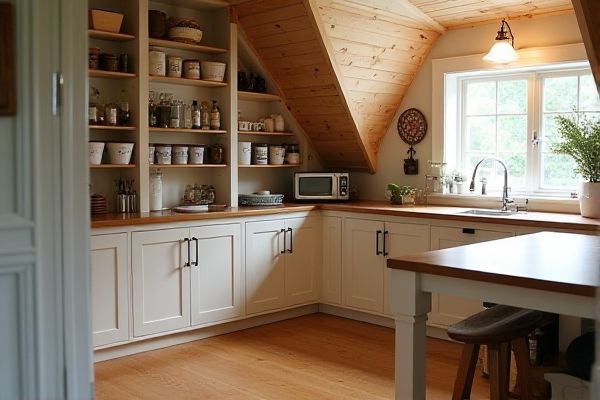
Attic pantry storage offers a unique solution by utilizing overhead space for less frequently used items, freeing up valuable kitchen pantry room for everyday essentials and easy access. Explore this article to discover which pantry setup best fits Your home's storage needs and lifestyle.
Table of Comparison
| Feature | Attic Pantry Storage | Kitchen Pantry |
|---|---|---|
| Location | Located in the attic, above living spaces | Adjacent or near the kitchen area |
| Accessibility | Less accessible, requires stairs or ladder | Highly accessible during meal prep and cooking |
| Temperature & Humidity | Prone to temperature fluctuations and humidity | Controlled environment, typically climate stable |
| Storage Capacity | Often larger space for bulk storage | Limited by kitchen space, smaller capacity |
| Organization | Requires more effort for labeling and sorting | Easy to organize with shelves and containers |
| Uses | Long-term storage for non-perishables and bulk items | Daily or frequent access items |
| Energy Efficiency | No direct energy use; depends on insulation | May affect kitchen energy use if climate-controlled |
| Cost | Potentially higher renovation cost if converting attic | Usually part of standard kitchen build |
Introduction to Pantry Storage Solutions
Attic pantry storage offers a unique solution for maximizing unused overhead space, providing a cool and dry environment ideal for long-term food preservation. Kitchen pantry storage, typically located adjacent to cooking areas, allows for quick access and organized storage of frequently used ingredients and small appliances. Choosing the right pantry storage depends on kitchen layout, accessibility needs, and the types of items being stored.
What Is an Attic Pantry?
An attic pantry is a dedicated storage space located in the attic, designed to maximize vertical and often underutilized areas for food and supply organization. Unlike a traditional kitchen pantry, which is typically integrated within or adjacent to the kitchen, an attic pantry leverages typically unused attic space, allowing homeowners to store bulk items and seasonal foods while freeing up kitchen storage. This setup is especially beneficial in homes with limited kitchen square footage, providing a cooler, less humid environment ideal for long-term pantry storage.
Key Features of a Kitchen Pantry
A kitchen pantry offers easy accessibility, organized shelving, and climate control suitable for frequently used ingredients, enhancing meal preparation efficiency. Spacious design and adjustable storage solutions accommodate various food items, utensils, and small appliances, optimizing kitchen workflow. Unlike attic pantry storage, kitchen pantries prioritize convenience and quick inventory management within the main cooking area.
Space Utilization: Attic vs. Kitchen Pantry
Attic pantry storage maximizes underutilized vertical space, offering larger capacity for bulk items and seasonal goods without crowding your kitchen area. Kitchen pantries provide easy access and streamlined organization for daily essentials but typically have limited square footage and lower ceiling height. Choosing attic storage enhances overall home organization by freeing up kitchen space while utilizing seldom-used attic zones efficiently.
Accessibility and Convenience Comparison
Attic pantry storage often presents challenges in accessibility due to limited stair access and lower lighting, making it less convenient for daily use compared to a kitchen pantry. Kitchen pantries provide immediate, easy reach to stored items, enhancing convenience during meal preparation and restocking. Optimizing kitchen pantry layout with adjustable shelves and pull-out drawers further improves accessibility for frequently used groceries and household supplies.
Climate Control and Food Preservation
Attic pantry storage often faces challenges with climate control due to temperature fluctuations and humidity, which can negatively impact food preservation by accelerating spoilage and encouraging mold growth. Kitchen pantries benefit from consistent indoor climate conditions, maintaining optimal temperature and humidity levels to extend the shelf life of your food. Prioritizing a pantry with stable climate control ensures your groceries remain fresh and safe for longer periods.
Cost and Installation Factors
Attic pantry storage typically involves higher installation costs due to the need for structural modifications, insulation, and ventilation to maintain food quality, whereas kitchen pantry setups are generally more affordable and easier to install with existing cabinetry or shelving. The cost of attic insulation and potential electrical work can increase your overall budget compared to standard kitchen pantry units that often require minimal alterations. Choosing between these options depends on your available space, willingness to invest in insulation for temperature control, and the complexity of installation.
Safety and Pest Management Considerations
Attic pantry storage poses higher risks for contamination due to inconsistent temperature control and potential moisture buildup, which attract pests like rodents and insects, compromising food safety. Kitchen pantry storage benefits from stable environmental conditions and easier access for regular cleaning, reducing the likelihood of infestations and spoilage. Proper sealing, ventilation, and pest proofing are critical for both, but the kitchen pantry requires less intensive management to maintain sanitary conditions.
Best Uses for Attic and Kitchen Pantries
Attic pantries are ideal for long-term storage of bulk items and seasonal food supplies due to their spaciousness and temperature stability, making them perfect for preserving canned goods, grains, and emergency provisions. Kitchen pantries excel in everyday accessibility and convenience, offering organized shelves for frequently used ingredients, snacks, and cooking essentials within easy reach during meal preparation. Combining both can optimize storage efficiency by relegating occasional-use or overflow items to the attic while maintaining primary foodstuffs and spices in the kitchen pantry.
Choosing the Right Pantry Storage for Your Home
Attic pantry storage maximizes unused vertical space and offers a secluded, temperature-stable environment ideal for bulk items, while kitchen pantry storage provides convenient accessibility and integrates seamlessly with daily cooking routines. Consider the size of your home, frequency of use, and types of stored goods when deciding between attic or kitchen pantry options. Choosing the right pantry storage enhances your home's organization and ensures your food supplies remain safe and easy to reach.
 homyna.com
homyna.com